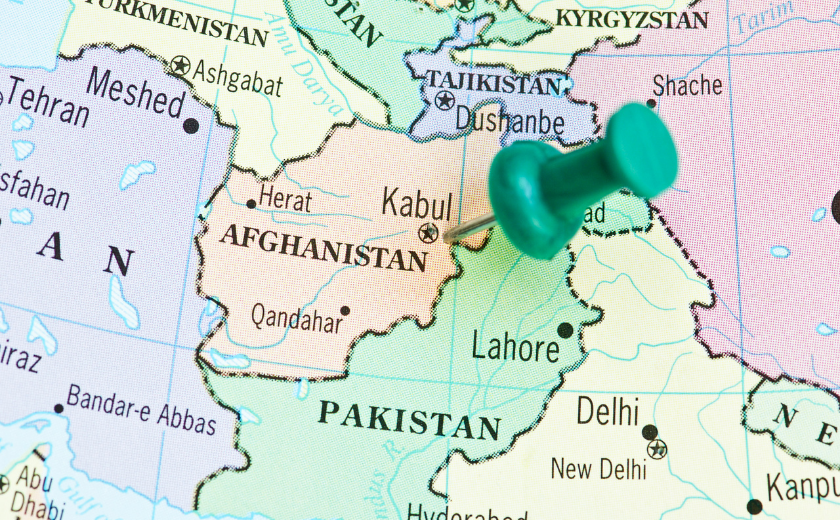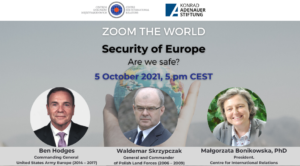
On August 31, 2021, the last US troops left the Kabul airport, bringing a close to the longest war in US history. For the Taliban – whom the Americans had removed from power 20 years ago – this was an occasion to celebrate the victory over the US and the end of the Western occupation, which they equate with the restoration of sovereignty. For Europe and America, it is loss of face, but also a question how to define relations with Afghanistan under the Taliban rule.
Afghanistan has never been a fully centralized country, and efforts to centralize state power under both the Soviet and American occupation have not brought lasting results. The government in Kabul did not control all of Afghanistan’s territory.
The project called “The Islamic Emirate of Afghanistan” may mean the return of the brutal rule as we know it from the 1990s and the ruthless violation of civil liberties and human rights, especially women’s rights. On the other hand, the Taliban face an enormous challenge of economic ruin and the poverty of most of the population. In order to function as a State, they also need recognition of at least some regional and global powers, including Russia and China. This offers some hope for more pragmatism and less extremism than in the past.
The causes of the defeat of the West
In 2001, the primary goal of the US invasion of Taliban-ruled Afghanistan was the destruction of al-Qaeda network, which had located its headquarters and training center in that country. The Taliban refused to extradite Osama bin Laden and paid for it not only by the loss of power in Afghanistan, but also by an almost total annihilation.
Washington and its allies, however, failed to do what Francis Fukuyama described as absolutely essential to the survival of any country: they failed to build institutions independent of the West, not only financially, but most importantly in terms of sustainability and credibility in society. The institutions built by the West in Afghanistan existed solely thanks to its funds and the presence of intervention troops. So when the West decided to withdraw, they necessarily had to collapse along with the state it created.
Allied troops, NGOs, and organizations affiliated with Western governments often acted as the main employer in a given area, and – worse – were buying peace by distributing funds among tribal leaders. Money for security and the illusion of stabilization – that type of corruption perpetrated by the West was a seed of the government’s collapse and contributed much to the fall of the entire system established by the Americans in Kabul in 2001. Unconditional funding, supporting local pro-government warlords, and turning a blind eye to their crimes against the population, the lack of security on a daily basis – all those factors aroused resentment among the inhabitants and contributed significantly to the resurgence of the Taliban movement in Afghanistan. In the socio-political conditions that were created, there could be no question of loyalty to the State – its institutions themselves were associated with the culturally foreign West. In this respect there are certain parallels with the pre-revolutionary Iran. The difference, however, is fundamental: In 2020, President Trump signed a pact with the Taliban that excluded the pro-American government in Kabul which proved to be the nail in the coffin of a quasi-democratic State which was being created by the Allies for twenty years in Afghanistan. Both the army and the tribal leaders playing a central role in the local socio-political system drew the only possible conclusion from the US deal with the Taliban: the country was handed over by Washington to the Taliban.
Therefore, there was no reason to fight for the pro-Western government in Kabul, as it no longer enjoyed the real support of the United States, and thus the protection of its troops and financial assistance. In addition, the number of military forces declared by President Joe Biden (300,000) was greatly exaggerated. In fact, the number of active soldiers may have been around 120,000-180,000 and has been undermined in the last two years by numerous desertions, including Afghans joining the Taliban. The rest of the money the Allies spent on security and defense was an “insurance policy” paid to tribal leaders in return for relative loyalty. However, even those existing forces – still serious in theory, after all – were largely dependent on the logistical, technical, training and military support of the Allied troops. The police and other security forces, on the other hand, were largely corrupt – to an even greater extent than the army – and their combat readiness was rather low.
These circumstances help to understand the success of the Taliban’s lightning offensive, the military’s lack of will to fight, and the collapse of the government epitomized by President Ashraf Ghani’s ‘escape’ from the country. The failure of the pro-Western political system resulted from the weakness of the State created by the US and Europe and not from the strength of the Taliban.
The Future of Afghanistan
The Taliban is not uniform. It’s made up of numerous factions and groups, not necessarily harmoniously cooperating with each other. This is already clearly visible in the discrepancies in the declarations of the central leadership and the practice of individual local commanders. All this weakens the stability of the government but also makes it difficult to exercise real control over the country.
One of the most radical and influential groups in the Taliban movement is the so-called The Haqqani Network (HN), founded by the leader of the clan Jalaluddin Haqqani from Paktia Province, who fought both the Soviets and US troops. During the US occupation, the Haqqani Network had its headquarters in Pakistan, in northern Waziristan. HN’s founder’s sons, Sirajuddin and Anas, are part of the top Taliban leadership, and the group maintains close ties with Pakistan’s secret services, allowing Islamabad to have a significant impact on the policies of the new government in Kabul.
On the other hand, however, a possible civil war in Afghanistan may cause instability in Pakistan itself. The Taliban movement consists mostly of Pashtuns and they are one of the ethnic groups in Pakistan as well. It is, therefore, an interconnected system, and Islamabad is primarily concerned with stopping the armed conflict that has been going on for almost two generations.
Brussels and Washington also expect – although it is not openly spoken of for obvious reasons – that the Taliban regime will solidify and that they are in power to take effective control of the entire country. It is about two things: eliminating the common enemy, which is the Islamic State of Khorasan province (IS-K) and ensuring general security in Afghanistan, and on the other hand – preventing possible waves of refugees. Therefore, a tactical cooperation between the West and the Emirate is necessary – despite mutual hostility.
Overwhelmingly, IS-K is made up of ex-Taliban, disillusioned by the less extreme interpretation of the Islamic Sharia law their parent movement now preaches compared to that practiced in the 1990s. Another motive for powering the ranks of IS-K by extreme-minded jihadists is the specific Taliban nationalism, their “Afghanness” and “local” character, which definitely distinguishes the Emirate from the Islamic State.
In its declarations, the Taliban wants to reassure the world that Afghanistan will not again become a training base and safe haven for terrorist groups planning attacks on targets in America or Europe. Of course, the question remains whether the Taliban will really want to eliminate groups such as IS-K or foreign jihadists, and if they are capable of doing that in the first place. There may be as many as 10,000 foreign fighters in Afghanistan.
IS-K, like the Islamic State of Iraq and Syria (ISIL), is an internationalist movement that does not recognize national borders or cultural differences. Also, while the Taliban itself is known for persecuting the Hazara Shiite ethnic minority, IS-K wants to destroy the Shi’ite branch of Islam as such, even if it means the physical elimination of the Shi’ite population in Afghanistan.
Another serious problem – directly affecting such regional powers as China and Russia – is a possible exodus to Afghanistan of fighters of Tajik, Uzbek or Uyghur origin from the Syrian province of Idlib. Their possible activity in Central Asia may destabilize that region. There are serious reasons for this – a growing aversion towards non-Syrians and non-Arabs within the main Islamist group in Idlib which is Hayat Tahrir ash Sham (HTS). Such a development might lead to further the chaos in Afghanistan and an increase of IS-K’s power in a situation where the Taliban need to govern the country and produce at least a minimal economic recovery. The problems of the Emirate may mean an influx of recruits and the strengthening of the “Islamic State”.
The horrible terrorist attack at the Kabul Airport (HKAP) on August 26, 2021 is a clue as to how IS-K intends to act in Taliban-ruled Afghanistan. Paradoxically, this does not necessarily work against the Emirate, as repeated attacks will force the West to tactically support the Taliban in its struggle with the Islamic State. However, such cooperation may not possible for ideological reasons on the part of the Emirate. If so, there is another way to act. President Joe Biden’s declaration as well as the American drone strikes on the likely masterminds of the August 26 attack show that the USA is ready to make limited strikes on targets in Afghanistan without consulting the Taliban government.
Lessons for the West
One of Europe’s fundamental concerns are possible new waves of refugees which may cause – as was the case in the past – political destabilization in the EU through the rise of populists to power, and threaten the European project itself. Currently, Afghans fearing the Emirate are trying to flee to Pakistan and Iran. Through Iran, however, the road leads to Turkey and the European Union. Turkey, struggling with almost four million Syrian refugees, is, of course, not interested in such a development. But if there is a larger influx of refugees in the future, Ankara will not hesitate to send them to the European Union and will put pressure on Brussels. This happened after the 2015 refugee crisis and led to a deal between the EU and Turkey, based on which the EU contributed 6 billion euros for refugee centres in Turkey in return for which Ankara kept irregular migrants on its territory.
For the above-mentioned reasons: security and a possible mass irregular migration to Europe, the Emirate probably does not have to fear a long-term freezing of foreign development aid, and even less of humanitarian aid. The West cannot afford it. Europe – whether it wants it or not – must find a way to have its humanitarian and aid NGOs present in the Taliban-ruled Afghanistan. And, unfortunately, it cannot hope for exerting a significant influence on the human rights situation in that country. This opportunity got lost in the 2001-2021.
The United States, on the other hand, drew one fundamental lesson from the twenty-year occupation (‘forever war’) of Afghanistan. Joe Biden, in his address to the nation, clearly stated that for the USA the era of building or transforming states in other parts of the world by means of large military operations has came to a close. It is doubtful, however, that that statement will stand the test of time. The fact remains, however, that Washington’s involvement in Afghanistan has cost the US taxpayer two trillion dollars, or $ 300 million a day for 20 years.
Possible Role of Beijing
For the Taliban itself, the biggest challenge right now is re-starting the economy and State institutions. The income from opium and internal and external customs duties and taxes is only sufficient to satisfy rudimentary needs. Also, Taliban wants to eliminate opium for religious reasons, and in the past they have shown greater effectiveness in this respect than the pro-Western government in Kabul.
The geopolitical vacuum left by the US and its Allies may be filled by other powers competing with Washington. The most likely candidate is China, which – as mentioned above – is concerned about the prospect of jihadism being exported across the Afghan-Chinese border to Xinjiang Province. It is therefore not surprising that Foreign Minister Wang Yi met one of the top Taliban leaders, Mullah Baradar on July 28, 2021 in Tianjin. The Taliban has pledged that “they will never allow any force to use Afghan territory to act to the detriment of China.” It is about the Islamic Movement of East Turkestan (ETIM), which, in the words of Wang Yi, “poses a direct threat to China’s national security and territorial integrity.” This is a sine qua non condition that Beijing places on the new government in Kabul. The Chinese make economic assistance and aid or investments in Afghanistan dependent on compliance with it. The investments themselves – including those under the Belt and Road Initiative (BRI) – are anyway a distant prospect as Beijing must make sure that the Emirate can provide security on its territory. In this respect, therefore, China can play a constructive role in Afghanistan.
Author: Bruno Surdel, PhD, analyst, Centre for International Relations
[evc_interactive_banner type=”classic” custom_link=”url:https%3A%2F%2Fmastersandrobots.tech%2F|||”]




